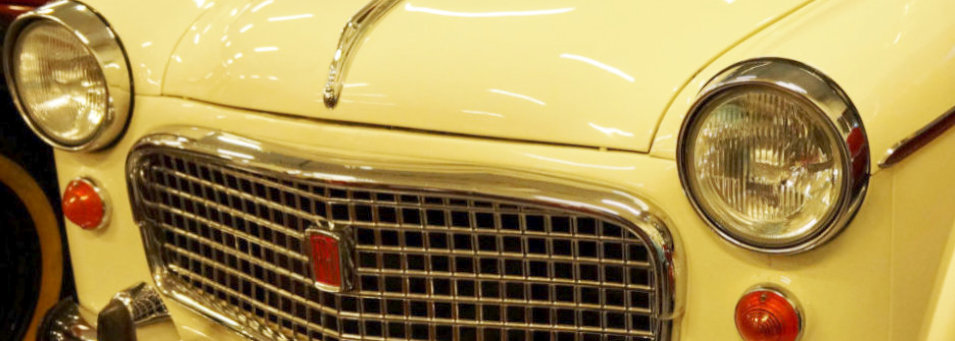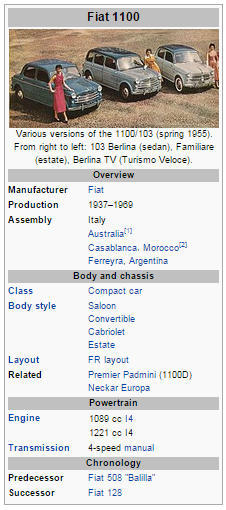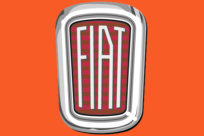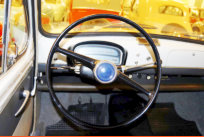



D for Delight - R for Rinnovata

FIAT 1100 - 63
The Fiat 1100 is a compact automobile produced from
1937 to 1969 by the Italian car maker Fiat. It was built in
several generations, with a separate chassis (until 1953)
and then monocoque bodywork.
The 1100 was changed steadily and gradually until finally being replaced by the inventive new Fiat 128 in 1969. There were also a series of light commercial versions of the 1100 built, with later models called the Fiat 1100T, which remained in production until 1971. The Fiat 1100D also found a long life in India, where Premier Automobiles continued to build the car until the end of 2000. er 1204 TS.508C Nuova Balilla 1100
The Fiat 1100 was first introduced in 1937 as an updated version of the 508 "Balilla" (its real name was the 508C) with a look similar to the 1936 Fiat 500 "Topolino" and the larger 1500, with the typical late-thirties heart-shaped front grille, with styling by the emerging designer Dante Giacosa. It was powered by a 1,089 cc four-cylinder overhead-valve engine rather than the earlier Balilla's 1-litre unit. Power was up by a third, to 32 PS (24 kW) at 4000 rpm. There was also a more sporting model on offer, the 42 PS (31 kW) "508 CMM". Drive was to the rear wheels through a four-speed gearbox, and for the period, its comfort, handling, and performance were prodigious, making it "the only people's car that was also a driver's car". Unusual for a modestly priced car of the time was the independent front suspension, while the rear had a leaf sprung live axle. Subsequently the car underwent a partial restyling around the front end and gained new streamlined window-shaped louvres and was renamed the 1100B and was popularly known as the "1100 musone" (i. e. "big nose"). After World War II, in 1949, the car was re-introduced with a curvy trunk and new name, the 1100E. The 1100E also received a bit more power, and now had 35 PS (26 kW). Both the 508C and the 1100B were also available as the long wheelbase 508L which was mainly used for vans and taxis.1100–103
In 1953, the 1100 was completely redesigned as a compact four-door sedan, with a modern monocoque bodywork and integrated fenders and front lights. The new model was called the 1100/103 after its project number, and was offered (as usual at that time) in two different versions: "economica" (cheaper) and "normale" (standard). In October 1953, the car became available in a sporty version, the 1100TV (Turismo Veloce) with a third light in the middle of the grille and 51 PS (38 kW) rather than the 36 PS (26 kW) of the regular versions. It was also available in station-wagon version, with a side-hinged fifth door at the back. In March 1955, the 1100/103 Trasformabile, a two-seater roadster, was introduced at the Geneva Motor Show. Equipped with the mechanics from the 1100TV, the American-inspired design was the work of the special bodies division of Fiat (Sezione Carrozzerie Speciali). 571 of these first series Trasformabiles were built. In 1956 it received a more powerful engine (three more horsepower) and a modified rear suspension; 450 more of these were built. From 1957 the Trasformabile was equipped with the more powerful 55 PS (40 kW) "1200" engine (1,221 cc). Production of this model continued until 1959, with circa 2,360 of the 1.2 liter Trasformabiles built. The 1.2 also received slight changes to the front and rear design, with bigger headlights being the most noticeable difference. Between 1956 and 1960, the new 1100 underwent several slight changes in fittings and details, e.g. newly designed grille, more rectangular profile, dual color dressing, and eventually small fintails with spear-shaped backlights. A special version, the 1100 Granluce (i.e. "Large light"), no longer with rear-hinged-doors, launched in 1959, had both fintails and wider windows. As an option it could be fitted with a new powerful 1221 cc engine. The Fiat 1100/103 was imported and sold by Premier Automobiles Limited (PAL). The older model was known as the Millecento and the one with the center light on the front grille as the Elegant. In 1958, the fintail model was introduced as the Select. It was followed by the Super Select in 1961. By 1964, the 1100D was introduced and it was assembled in India by PAL. This model has most of the parts manufactured locally. In India it was considered a sportier alternative than the Hindustan Ambassador.1100D
Retaining the exterior changes of this model, in 1962 Fiat introduced the third generation 1100, called the 1100D ("D" stood for Delight). It was a sober yet comfortable four-door sedan, very similar to the Granluce but with simpler sides and a new simpler rectangular front end. The 1100D was a successful Italian Standard in the early sixties and along with its own Estate or Family car version and a Deluxe model that offered a higher performance of 50 PS (37 kW), extra side moldings, front bench seat with two reclining backs and carpet floor mats. These survived without any substantial alteration until 1966, when the introduction of the groundbreaking 124 model imposed a further change in styling. Power was 40 PS (29 kW) at the time of introduction, which was soon increased to 43 PS (32 kW). The Fiat 1100D was manufactured under licence in India by the Premier Automobiles Limited beginning in 1964. The vehicle was initially marketed as the Fiat 1100D, as the Premier President for model year 1972, and as the Premier Padmini since 1974 until its discontinuation in 2000. By 1993, a diesel version with a 1366 cc diesel engine made in collaboration with FNM from Italy and was badged as the Premier Padmini 137D.The car manufacturing plant was closed down by 2000.1100R
The very last 1100 model, born in February 1966, was the 1100R ("R" stood for Rinnovata). It had a longer, straighter and slimmer line, with a square back and a front-end look not very different from its bigger sister the Fiat 124. In terms of styling cues, the vestigial fins were further suppressed and the simple round rear light cluster from the Fiat 850 replaced the vertical form seen on the 1100D. At the same time, the larger engine was withdrawn in order to avoid undue overlap with the 124. The 1100R was offered only with the older 1,089 cc engine, now with a compression ratio of 8:1 and a claimed output of 48 bhp (36 kW). This engine (with a somewhat narrower bore) had been first introduced in the 1932 Balilla. Clutch and gearbox were little changed, but the return of a floor mounted gear lever positioned between the front seats and connected to the gearbox with a rod linkage system was welcomed by the motoring press. The absence of synchromesh on the bottom forward speed nevertheless offered a reminder that under the surface this was becoming a somewhat aging design. Between the gearbox and the differential, the propeller shaft had now been separated into two parts with three couplings. The boot was usefully expanded, helped by a slight increase in the car's overall length, and with more careful packaging of the spare wheel (under the floor) and the fuel tank (in the rear wing on the right). As configured for UK sales, reclining front seats were available as an optional extra for £8. The 1100R finally gave way in 1969 to the new middle-class Fiat 128. It was also assembled by the Neckar-Automobilwerke in Heilbronn, Germany. Called the Neckar 1100 Millecento it only differed lightly in trim.1100T
The 1100T was made from 1957 as a van, pickup and bus. The car was equipped with a in-line engine with 1,089 cc (type 103 D.007) with 38 PS (28 kW) at 4800 rpm and it had a top speed of 90 km/h (56 mph). In 1959, its successor was unveiled, the Fiat 1100 T2, that had a 45 PS (33 kW) 1,222 cc engine. Production continued with a steady stream of updated engines, until production of the 1100 T4 finally came to an end in 1971.
1963
Engine 1098 cc 4 cylinders 48 hp Transmission 4-speed manual Top speed 120 km/h

Photos mainly by Matti Kreivilä. Historical facts and technical details of the vehicles provided by Wikipedia. Movies YouTube.



- Decade of 60's
- Austin 850 Pickup - 1962
- Chaika Tshaika 13 GAZ - 1962
- Citroen 2CV - 1961
- DKW Junior - 1961
- Fiat 1100 - 1963
- Ford Taunus 12M - 1961
- GLAS 1204 - 1963
- MG 1100 - 1964
- Moskvich 407 - 1961
- Nagetusch caravan - 1961
- NSU Printz 4 - 1961
- Opel Kadett A - 1964
- Panhard PL17 - 1961
- Peugeot 404 - 1962
- Renault Dauphine - 1965
- Simca Aronde P60 - 1960
- Simca 1000 - 1966















